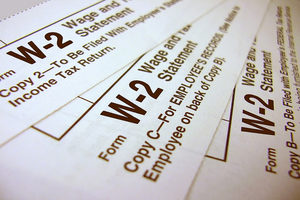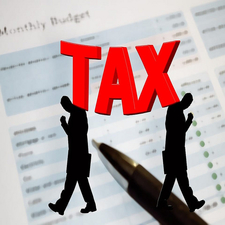Often times I hear friends wonder out loud about their income tax bracket or tax rate.
For the longest time, I was confused about my income tax bracket and how to find it. I tried to calculate it but it was never the same as what was reported on my income tax software.
Usually, my calculation was always higher than the IRS calculations. I thought you just multiply your taxable income by your tax bracket. Well, that is not how it is calculated.
As a result, I was always a little nervous when I reported my taxes. After a few years, to my relief, I discovered how the IRS calculates everyone’s taxes.
The 2018 Federal income tax has 7 new tax bracket rates: 10%, 12%, 22%, 24%, 32%, 35%, and 37%. The amount of tax you owe depends on your income level and filing status. These tax changes are effective as of January 1, 2018.
How tax brackets work

First of all, let’s discuss what is meant by a "tax bracket." Experts call this the marginal tax rates. Tax brackets tell you the tax rate you pay on each dollar of your taxable income.
When I talk about my tax bracket or tax rate, I am generally referring to my "marginal" tax rate -- the rate at which my last dollar of taxable income is taxed. It's the maximum rate I am paying on any (not all) of my dollars of taxable income.
In other words, if my taxable income falls within the 22% tax bracket for my filing status, that doesn't mean I'll pay the IRS 22% of my taxable income. Instead, I'll pay 10% on some of my income, 12% on another portion of my income, and 22% on income above a certain threshold.
Put another way, my marginal tax rate is the rate I'll pay on my highest dollar of income, not an overall tax rate.
My marginal tax rate deals only with the specific tax on my income. I may have to pay other taxes as well, such as self-employment taxes, the alternative minimum tax, and even penalty taxes on retirement-plan distributions. I may also benefit from credits, including the child tax credit, the dependent care credit, or the education credits.
The effective tax rate is simply your my tax obligation, including my income tax and any other additional taxes and/or credits, divided by my total taxable income. Continue reading to learn more about the effective tax rate.
For self-employed folks, your effective tax rate could very well be much higher than your marginal rate, since you'll be paying the self-employment tax in addition to your normal income tax.
So, let’s dig into this.

Carlota is a friend who wants to share how her income taxes are calculated so that we will have more clarity on this topic.
Carlota is single. In 2018, if she has taxable income of $9,525 or less, her marginal tax rate will be 10%. But if her taxable income was between $9,526 and $38,700, her marginal tax rate will be 12%.
In the same way, if her taxable income was between $38,701 and $82,500, her marginal tax rate will be 22%. See how it works?
Therefore, if Carlota has taxable income of $40,000, (line 10 on the new 1040) the first $9,525 of her taxable income would be taxed at 10% (resulting in a tax liability of $952.50), the next $29,174 would be taxed at 12% (creating a tax liability of $3,500.88), and the remaining $1,299 would be taxed at 22% (yielding an additional liability of $ 285.78).
Add those liability amounts together, and Carlota’s total tax liability: $4739.16 (line 15 on the new 1040).
When looking at the big picture, you should compute your effective tax rate, which is simply your total tax liability divided by your taxable income. On my 1040 Form, line 15 divided by line 10.
In Carlota's example, while her marginal tax bracket is 22%, her effective tax bracket is 12% ($4739.16 divided by $40,000 equals 0.12). As a result, the effective rate tells Carlota that most of her income is being taxed at the lower 10% and 12% brackets, and only a small portion is being taxed at the next (22%) bracket.
So, to summarize Carlota's tax situation:
- Carlota's marginal tax rate: 22%.
- Carlota's effective tax rate: 12%.
- Most of her dollars were taxed at the lower 10% and 12% tax rates.
- Her remaining dollars ($1,299) were taxed at 22%.
Federal Income Tax Tables

Single
| Taxable Income | Tax Rate |
| $0 - $9,525 | 10% of taxable income |
| $9,526 - $38, 700 | $952.50 plus 12% of the amount over $9,525 |
| $38,701 - $82, 500 | $4,453.50 plus 22% of the amount over $38,700 |
| $82,501 - $157,500 | $14,089.50 plus 24% of the amount over $82,500 |
| $157,501 - $200,00 | $32,089.50 plus 32% of the amount over $157,500 |
| $200,001 - $500,00 | $45,689.50 plus 35% of the amount over $200,000 |
| $500,001 or more | $150,689.50 plus 37% of the amount over $500,00 |
Married Filing Jointly or Qualifying Widow(er)
| Taxable Income | Tax Rate |
| $0 - $19,050 | 10% of taxable income |
| $19,051 - $77,400 | $1,905 plus 12% of the amount over $19,050 |
| $77,401 - $165,00 | $8,907 plus 22% of the amount over $77,400 |
| $165,001 - $315,000 | $28,179 plus 24% of the amount over $165,000 |
| $315,001 - $400,000 | $64,179 plus 32% of the amount over $315,000 |
| $400,001 - $600,000 | $91,379 plus 35% of the amount over $400,000 |
| $600,001 – more | $161,379 plus 37% of the amount over $600,000 |
Married Filing Separately
| Taxable Income | Tax Rate |
| $0 - $9,525 | 10% of taxable income |
| $9,526 - $38,700 | $952.50 plus 12% of the amount $9,525 |
| $38,701 - $82,500 | $4,453.50 plus 22% of the amount over $38,700 |
| $82,501 - $157,500 | $14,089.50 plus 24% of the amount over $82,500 |
| $175,501 - $200,000 | $32,089.50 plus 32% of the amount over$157,500 |
| $200,001 - $300,000 | $45,689.50 plus 35% of the amount over $200,00 |
| $300,001 or more | $80,689.50 plus 37% of the amount over $300,00 |
Head of Household
| Taxable Income | Tax Rate |
| $0 - $13,600 | 10% of taxable income |
| $13,601 - $51,800 | $1,360 plus 12% of the amount over $13,600 |
| $51,801 - $82,500 | $5,944 plus 22% of the amount over $51,800 |
| $82,501 - $157,500 | $12,698 plus 24% of the amount over $82,500 |
| $157,501 - $200,000 | $30,698 plus 32% of the amount over $157,500 |
| $200,001 - $500,000 | $44,298 plus 35% of the amount over $200,00 |
| $500,001 or more | $149,298 plus 37% of the amount over $500,000 |
In conclusion
Although these tax brackets are lower than 2017 tax brackets you could still pay more income taxes in 2018 than you did in 2017. Above all, I always remind myself that moving into a higher tax bracket does not mean that all of my income will be taxed at a higher rate. Instead, only the money that I earn within a particular bracket is subject to that particular tax rate.
Do you have tax questions? Click here to get answers.
Funny Tax Quotations
Albert Einstein
[on filing for tax returns] This is too difficult for a mathematician. It takes a philosopher.
Dr. Laurence J. Peter
America is a land of taxation that was founded to avoid taxation.
Will Rogers
The difference between death and taxes is death doesn't get worse every time Congress meets.
